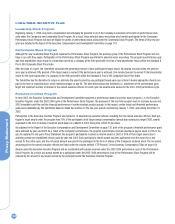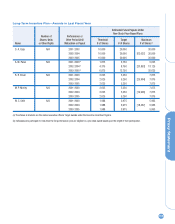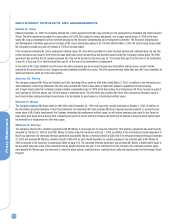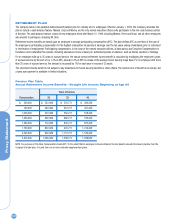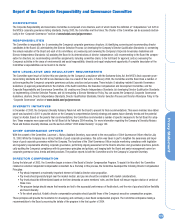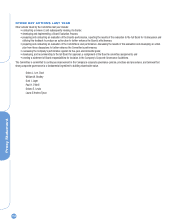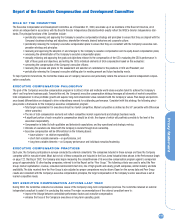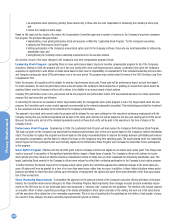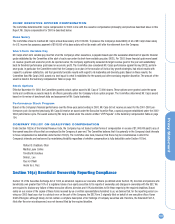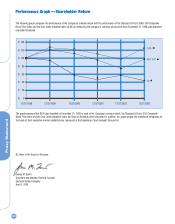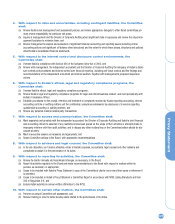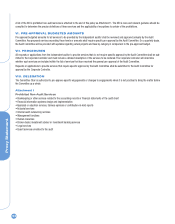Kodak 2003 Annual Report Download - page 118
Download and view the complete annual report
Please find page 118 of the 2003 Kodak annual report below. You can navigate through the pages in the report by either clicking on the pages listed below, or by using the keyword search tool below to find specific information within the annual report.
Proxy Statement
118
• de-emphasize stock options by granting these awards only to those who are most responsible for influencing the Company’s stock price;
and
• reduce the Company’s share usage.
Based on this input and the results of its review, the Compensation Committee approved a number of revisions to the Company’s long-term compensa-
tion program. The principal changes include:
• implementing a new global performance stock unit program, entitled the “Leadership Stock Program,” for the Company’s executives;
• replacing the Performance Stock Program;
• limiting participation in the Company’s annual stock option grant to the Company’s officers, those who are most responsible for influencing
shareholder value; and
• strengthening the Company’s share ownership requirements for its executive officers.
An overview of each of the major changes to the Company’s long-term compensation program follows:
Leadership Stock Program
Leadership Stock is a new performance-based, long-term incentive compensation program for all of the Company’s
executives. Starting in 2004, the program will run in two-year cycles with a new cycle beginning each January. Leadership Stock gives the Company’s
executives an opportunity to earn shares of Kodak stock based on their level of responsibility, an assessment of their individual leadership and execution,
and Company earnings per share (EPS) performance over a two-year period. The program was created under the terms of the 2000 Omnibus Long-Term
Compensation Plan.
Under the program, all executives will be eligible for awards of performance stock units. These units will be performance-based, not just time-based.
For most executives, the award of performance stock units will replace the Company’s historical practice of granting an annual stock option award. As
explained below, only the Company’s officers will continue to be eligible for an annual award of stock options.
Company EPS performance (over a two-year period) will be the program’s sole performance metric. EPS was selected because it is a basic operational
measure that each executive can influence.
In converting the amount of an executive’s former target award under the management stock option program to his or her target award under the new
program, the Committee used a value-neutral approach recommended by the external independent consultant. This methodology provided fair treatment
to the executives and was sensitive to the interests of the Company’s shareholders.
The payment of any stock units earned under the program will be delayed for one-year contingent on the executive’s continuous employment with the
Company. During this year, dividend equivalents will be paid on the stock units, but they too will be subject to this one-year vesting period. At the end of
this year, the stock units, and all of the dividend equivalents earned on these stock units, will be paid to the executive in the form of shares of the
Company’s stock.
Performance Stock Program
Commencing in 2004, the Leadership Stock Program will also replace the Company’s Performance Stock Program.
This was a program for the Company’s top executives that measured performance over a three-year period based on the Company’s relative shareholder
return. The decision to replace the program was driven based on the study’s recommendations to improve the linkage between controllable performance
and executive compensation, and the desire to enhance the focus on the Company’s long-term operating goals. The target awards under the Leadership
Stock Program for those participants who were formerly eligible for the Performance Stock Program were increased to reflect their former participation
in this program.
Stock Option Program
Effective with the fall 2003 grant, only the Company’s officers are eligible for an annual stock option grant. This change was
made in large part in recognition of the significant potential dilutive impact of these types of awards. The Company’s officers will continue to receive
stock options since they remain an effective incentive compensation vehicle for those who are most responsible for influencing shareholder value. The
target Leadership Stock awards for the Company’s officers were reduced to reflect their continuing participation in the Company’s stock option program.
To further minimize the dilution impact of the Company’s stock option grants, the Committee approved two additional changes to the stock option pro-
gram. All options will now be granted for a term of no more than seven years, rather than ten years. In addition, in those limited situations where partici-
pants are permitted to retain their stock options upon termination of employment, the options will expire three years thereafter, rather than upon expira-
tion of their normal term.
Share Ownership Requirements
To strengthen the alignment of the personal interest of the Company’s executive officers with those of its share-
holders, the Committee made several changes to its Share Ownership Program. Most importantly, these changes increase the stock ownership require-
ments for the CEO from four to five times base salary and incorporate a “retention ratio” concept into the guidelines. The retention ratio concept requires
an executive officer to retain a specified percentage of the shares attributable to stock option exercises or the vesting and earn-out of full value shares
until the executive officer attains his or her ownership requirements. This is in lieu of requiring that the guidelines be met within a fixed number of years.
As a result of these changes, the share ownership requirements will operate as follows:


